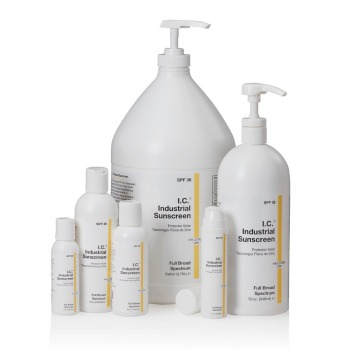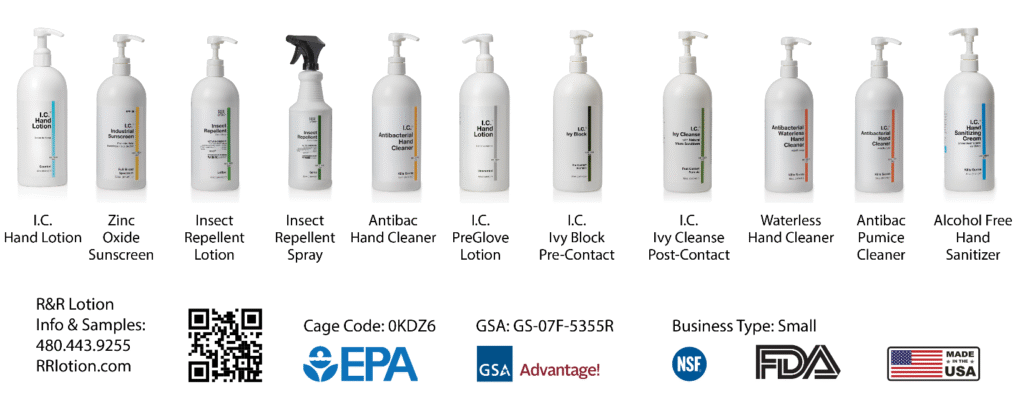Why R&R Lotion Chose Zinc Oxide: A Smarter Sunscreen for Heat Stress and UV Protection
By: R. Fletcher Rich
Rethinking Sunscreen Protection and Heat Stress for Outdoor Workers
For outdoor workers, sun protection is about more than preventing sunburn—it’s about preserving skin health, reducing long-term risks, and managing Heat Stress under intense environmental exposure. As temperatures climb and UV levels rise, understanding how different types of ultraviolet radiation interact with the body—and how sunscreen ingredients influence that interaction—has become more important than ever.
At R&R Lotion, our mission has always been to support the safety and wellness of workers in high-risk outdoor environments. That’s why, in the 1990s, we made the deliberate decision to use Zinc Oxide, a Mineral-based sunscreen active ingredient, instead of chemical filters like Avobenzone. That choice wasn’t just a trend—it was a science-backed commitment to health, performance, and environmental integrity.
How UVA and UVB Rays Creates Heat Stress in Outdoor Workers
Sunlight emits two main types of ultraviolet radiation that affect human skin, UVA and UVB. While both can lead to damage, they differ in how they penetrate and heat the body.
UVB rays make up a smaller portion of the UV spectrum but carry higher energy due to their shorter wavelengths (280–320 nanometers). They primarily affect the epidermis, the outermost layer of the skin. This is the form of UV radiation responsible for sunburn, characterized by red, inflamed, and painful skin. The body responds by increasing blood flow and inflammation in the exposed area, which causes a noticeable rise in surface temperature. Over extended periods, this heat accumulation—compounded by the UV energy and even the sunscreen in use—can lead to localized skin heating and contribute significantly to overall heat stress, especially for those performing physical labor outdoors.
UVA rays, on the other hand, have longer wavelengths (320–400 nanometers) and account for about 95% of UV radiation that reaches Earth’s surface. Unlike UVB, UVA Rays penetrate deeper into the dermis, the skin’s structural layer, where they affect collagen, elastin, and even DNA. UVA does not cause sunburn, but it is strongly linked to Photoaging, Hyperpigmentation, and Skin Cancers. It is also capable of reflecting off surfaces like concrete, sand, snow, water, metal, runways and glass, which can double a worker’s exposure—from both direct and reflected rays.
Long-term UVA exposure generates oxidative stress within cells, damages connective tissues, and disrupts DNA. For workers on rooftops, pavement, or open water, UVA radiation doesn’t just age the skin—it contributes to internal heating and physiological strain throughout the day.
Avobenzone: How Chemical Sunscreens Can Add to Heat Stress
Avobenzone is one of the most common chemical sunscreen ingredients used for UVA protection. It works by absorbing ultraviolet radiation, which excites its molecular electrons to a higher energy state. As those electrons return to their normal state, the absorbed energy is released as heat, usually on or near the skin’s surface. This process helps shield the skin from UV damage—but also contributes to thermal buildup, which is problematic in high-heat working conditions.
In addition to generating heat at the skin’s surface, Avobenzone presents several challenges due to its chemical properties. As a chemical sunscreen filter, it must be applied at least 20 minutes before sun exposure to allow time for absorption and activation within the skin. However, Avobenzone is inherently photo unstable meaning it begins to degrade rapidly when exposed to sunlight. Studies show that within the first hour, its ability to absorb UVA radiation declines significantly, and by the second hour, its efficacy is substantially reduced. This breakdown produces reactive photodegradation byproducts, such as free radicals and aromatic compounds, which may contribute to oxidative stress, skin irritation, and photoallergic reactions. Because there are no practical methods to determine how much active protection remains after application, the FDA recommends reapplying chemical sunscreens like Avobenzone every two hours to maintain effective protection—especially for those under continuous sun exposure.
Because Avobenzone does not offer UVB protection, it must always be combined with other active ingredients to achieve full broad-spectrum coverage. This increases formulation complexity and introduces more chemicals to the skin—some of which are associated with systemic absorption, hormone disruption, or environmental toxicity. It is no surprise that Avobenzone has been banned in certain marine areas, such as the State of Hawaii, due to its potential to harm coral reefs and are prohibited for sale without a doctor’s prescription.
Additionally, when Avobenzone isn’t properly solubilized in the formulation process, it can crystallize over time, particularly when exposed to heat—like when a bottle is stored in a hot car. This not only reduces SPF performance but also leads to instability and permanent yellow staining on clothing, especially noticeable on white fabrics.
For outdoor professionals who require consistent, non-irritating, and thermally neutral protection, these drawbacks represent significant concerns.
Zinc Oxide: Stable, Broad-Spectrum Protection Without the Heat
Unlike chemical filters, Zinc Oxide is a mineral (physical) sunscreen that provides broad-spectrum protection by reflecting and scattering UV radiation. It is effective across UVA I, UVA II, and the full UVB spectrum, which means a single ingredient is capable of defending the skin from both sunburn and deeper dermal damage.
The critical difference lies in its mechanism of action. Rather than absorbing UV rays and converting them to heat, zinc oxide particles remain on the skin’s surface, forming a protective barrier that deflects harmful rays without creating heat. This makes it an ideal choice for workers facing Heat Stress, as it helps minimize both UV damage and thermal load on the skin. And because it does not require absorption into the skin, Mineral Sunscreens like Zinc Oxide offer immediate protection upon application—allowing users to step into the sun without waiting for activation time.
Zinc oxide is also one of only two sunscreen ingredients classified by the FDA as GRASE—Generally Recognized as Safe and Effective—for use in over-the-counter sun protection. Along with titanium dioxide, it is not under FDA review, unlike many chemical sunscreen actives whose long-term safety, absorption rates, and systemic effects are still being evaluated. This regulatory clarity reinforces zinc oxide’s reputation as a trusted, science-backed option for safe and effective sun protection.
Zinc oxide is naturally photostable—it doesn’t break down when exposed to sunlight, which means it continues to protect effectively without the need for stabilizers or reapplication as frequently. It’s non-irritating, non-sensitizing, and non-comedogenic, making it safe for people with sensitive skin or underlying skin conditions. Its anti-inflammatory properties may even help reduce redness and irritation during prolonged sun exposure.
Historically, one limitation of zinc oxide was its visible white cast, especially on darker skin tones. However, modern innovations have addressed this issue. Micronized zinc oxide reduces particle size, allowing for smoother, invisible application, while tinted formulations now match a wide range of skin tones. These advances have made zinc oxide not only the safest choice but also a cosmetically elegant one.
Why R&R Lotion Made the Choice For Zinc Oxide in the 1990s
R&R Lotion chose zinc oxide not because it was trendy, but because it aligned with our values: scientific integrity, long-term health, and real-world performance. For workers in construction, utilities, transportation, and other demanding industries, a Sunscreen must do more than block rays—it must perform under pressure.
By choosing Zinc Oxide, we offer a product that:
- Provides immediate and long-lasting protection
- Does not absorb or release heat
- Stays stable in high-temperature environments
- Minimizes skin irritation
- It is safe for marine ecosystems
- The FDA recognizes Zinc Oxide as a GRASE ingredient
In hot, high-exposure workplaces, reducing heat stress isn’t just about shade and hydration—it includes sunscreen formulations that work with the body, not against it.
A Smarter Approach to Skin Protection and Heat Stress
Both UVA and UVB rays pose real risks to outdoor workers—not just in the form of burns or long-term skin aging, but in their ability to raise skin temperature and compound heat stress throughout the workday. Chemical sunscreens like Avobenzone, while effective at absorbing UV radiation, may actually add to that thermal burden due to their heat-generating nature and photoinstability.
In contrast, zinc oxide offers clean, consistent, and cool protection. It reflects UV radiation instead of absorbing it, doesn’t degrade in the sun, and supports both Human Health and Environmental Safety. For workers facing daily exposure, that difference isn’t just technical, it’s critical.








